How To Create A Construction Programme In Excel
Planning a construction schedule can quickly become complex. Client priorities, budget, legal compliance are just some of the many things to consider. In this article, you'll learn how to make a construction schedule in 7 simple steps.
You'll learn:
- What is a construction schedule, it's functions & types?
- Why do you need a construction schedule?
- The 7 steps to make construction schedules
- Using Toggl Plan to create a building project schedule
- And finally, we'll look at a few construction schedule templates
Let's start.
What Is A Construction Schedule?
A construction schedule is a detailed plan. It outlines the activities, timelines, and resources involved in a construction project.
A well-planned schedule specifies what work will get done and when.
A construction project schedule answers the following questions:
- What construction activities will be undertaken?
- When will these activities start and end?
- What resources are needed to complete these activities?
Functions of a construction schedule
A well-planned construction schedule is a blueprint for success. It ensures the resources are used efficiently and projects are completed on time as well as within budget.
- Optimal resource usage: Proper scheduling ensures efficient management of labor, materials, and equipment. Thus, minimizing the risk of downtime due to shortages.
- Minimal downtime: The delays due to downtime can be costly. According to a study, the financial loss by a piece of inoperable construction equipment could be up to $2,800 per day.
- Cost estimation and control: Inaccurate project estimates are a leading cause of cost overruns. A well-planned schedule can detect deficiencies in initial estimates. And thus, prevent problems before they occur. It can also inform financial decisions by accurately forecasting project completion.
Types of construction schedules
Construction schedules can be classified into various categories, depending on:
- Construction type: such as residential, commercial, industrial, etc.
- Activities: such as material schedule, RCC work, curing, interiors, payments, etc.
- Timeline granularity: such as roadmaps, weekly submittals, hourly activities, etc.
Why Are Construction Schedules Important?
Before we jump into making a building schedule, it's critical to understand why you should create one. Benefits include:
- Greater project stability: A well-planned project is unlikely to encounter surprises down the road. There is greater control over the project outcome. Plus, all the low-level details prevent last-minute changes.
- Better quality control: Project quality and client satisfaction improve with a well-planned project. It ensures that the right construction materials are available in the right quantity throughout.
- Better resource planning: Scheduling helps plan resources like labor, equipment, and building materials. Clients can purchase the right materials at the right time. In addition, they know when to engage with subcontractors. And thus, complete the project on time.
- Easier activity planning: Everyone involved in the project can collaborate to better plan their activities. This includes general contractors, architects, subcontractors, laborers, and suppliers.
- A safer project: Safety is a major concern in any construction project. Using a schedule, you can identify when protective measures like earplugs, goggles, and hard hats will be needed.
How To Make A Construction Schedule?
Creating a construction schedule for your next building project may feel overwhelming. However, if you follow the steps below, you can make the entire process a lot smoother.
Step #1: Understand the construction project requirements
All projects begin with a kick-off meeting involving all the major stakeholders.
The purpose of this meeting is to understand and document the client's requirements, priorities, and objectives.
Step #2: Identify constraints and risks
Not all requirements can be delivered because of various constraints. Examples of constraints include budget, area, local construction codes, etc.
Risks are factors that negatively impact a project's goals, schedule, and budget. Availability of materials, labor, funds, weather, etc. are all examples of risks.
Both constraints and risks can derail your project. And, early identification helps you to plan your schedule around them.
Step #3: Establish project scope
Next, set the scope boundaries for the project. This is based on the information collected in the first two steps.
A project's scope defines what's included and what's not included in the project. It also helps manage scope creep better.

Both the contractors and the customers need to agree upon and freeze the scope. Failure to do this will result in poor management, delivery conflicts, and ultimately failure.
Step #4: Create a roadmap
Next, you'll identify the tentative start and finish dates for the project.
The finish date is estimated by breaking the project down into manageable phases. The end of each phase marks a milestone. Milestones serve as checkpoints for the project.
Learn more about how to create a project roadmap here.
Step #5: Submit a project proposal
So far, you've collected all the project related information and created a high-level project roadmap. Based on these, create a project proposal and get it approved by the customer.

A construction project proposal includes the project goals, scope, timeframe, and budget.
Step #6: Capture and prioritize project tasks
Once the customer accepts the proposal, you can move on to creating a detailed construction schedule.
To create an accurate schedule break down the project into detailed tasks. Also, from past experience, estimate the task efforts. In addition, identify, plan, and allocate the required resources.
Next, prioritize these tasks based on dependencies and constraints.
Step #7: Create a construction schedule timeline
With all the tasks captured and prioritized, you're ready to create the building construction schedule.
The construction schedule is mapped on to a timeline using a Gantt chart. A Gantt chart is a horizontal bar chart that displays the tasks along a timeline.
You can create this building schedule-timeline using Excel, Google Sheets, or the templates and software tools mentioned below.
How To Create A Construction Schedule With Toggl Plan?
Toggl plan is a beautifully simple project planning and execution tool.
Everyone, irrespective of their technical background, can make a construction roadmap and schedule with Toggl Plan. Plus, it makes collaboration with your construction crew and/or clients easy.
Toggl plan is free for solo users. Teams plans start at $9 per user, per month. Learn more about the pricing here.
Let's look at some ways you can use Toggl Plan for making a construction schedule.
Plan roadmaps & milestones
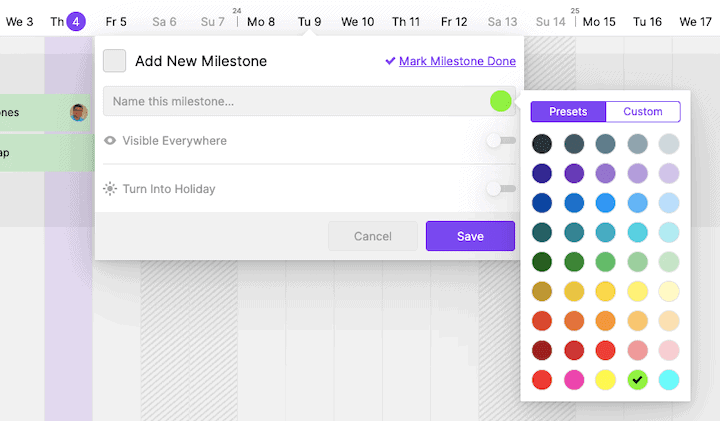
- Create color-coded roadmaps and milestones.
- Zoom in on a week, month, quarter, or year for a detailed or a birds-eye view of your construction project.
Plan a detailed project schedule

- Schedule one-time or recurring construction tasks on a timeline.
- Assign tasks to responsible team members along with daily effort estimates.
- Track progress visually.
Visually manage your resources
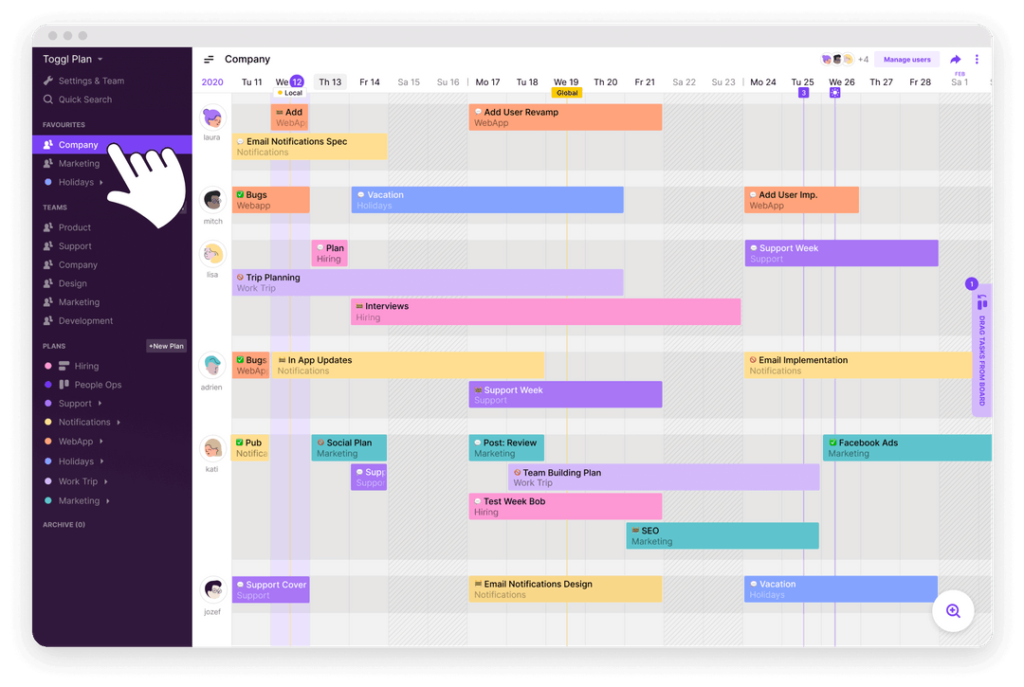
- Visually track what your entire team is working on, who's available, and who's on vacation.
- Adjust workloads on the fly to prevent burnout.
Construction Schedule Templates
There are a ton of Microsoft Office templates available online. Some of these are free, while others are premium.
However, you're better off using online project management software instead of templates. Here's why:
- Collaboration: Throughout the building process, you'll collaborate with sub-contractors and team members. Plus, you'll also need to share your plans and progress with clients. Project management tools make it easy to collaborate with.
- History: Unlike Excel, project management tools store the historical log of project activities. You'll know exactly what happened when. This is critical for resolving conflicts and improving your team's productivity.
- Security: Losing your construction project schedule in a computer-crash can be catastrophic. On the other hand, you can store all your project information securely with most online project software.
If you'd still like to try out some templates, we found the following quite useful.
Commercial Construction Schedule Templates
Roadmap template
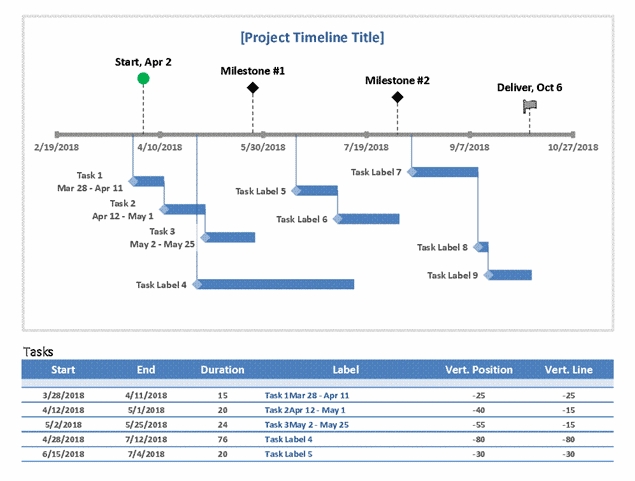
Use this template to create a high-level roadmap and identify milestones. Download this template from the MS Office templates portal here.
Construction Schedule Template
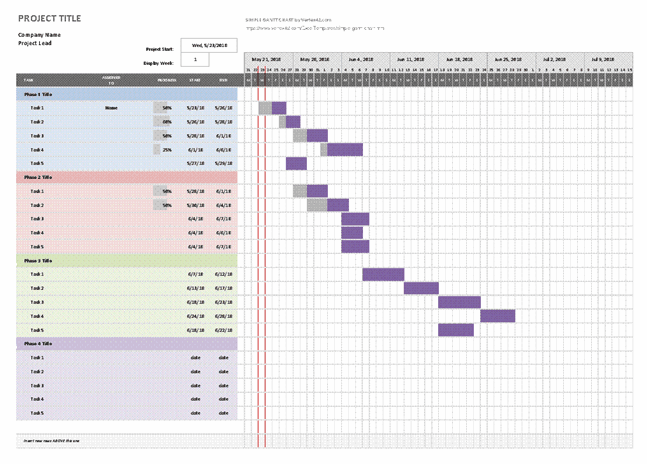
Break down a project into phases, plan a schedule, and track progress with this easy to use a template. Download this simple Gantt chart template for Excel from here.
Project Tracker Template
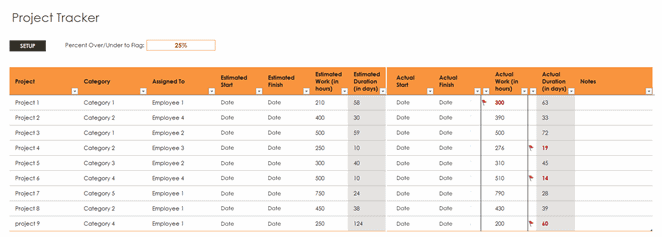
Track scheduled construction tasks by employee/sub-contractor. It also has built-in formulas and conditional formatting to quickly visualize over/under tasks. Download the tracker template here.
Residential Construction Schedule Templates
The commercial schedule templates can also be used for residential constructions. In addition, the following templates may be useful:
Construction Budget Template
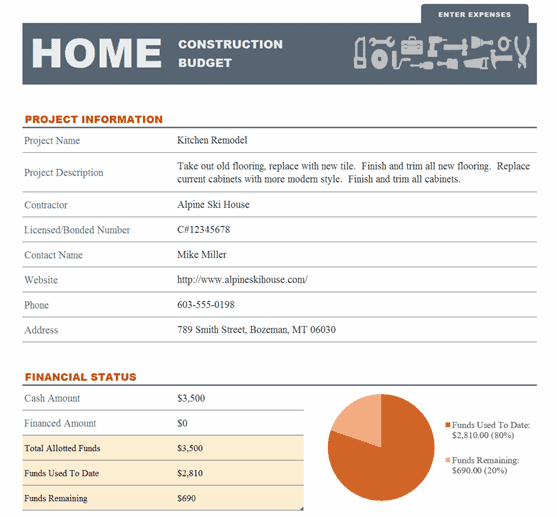
Use this template to plan and track the budget for a home improvement or construction project. Download this accessible template here.
Loan Schedule Template

Stay on top of your home improvement loan or mortgage. Plan and track your construction loan amortization schedule. Download this template here.
Payments Tracker Template
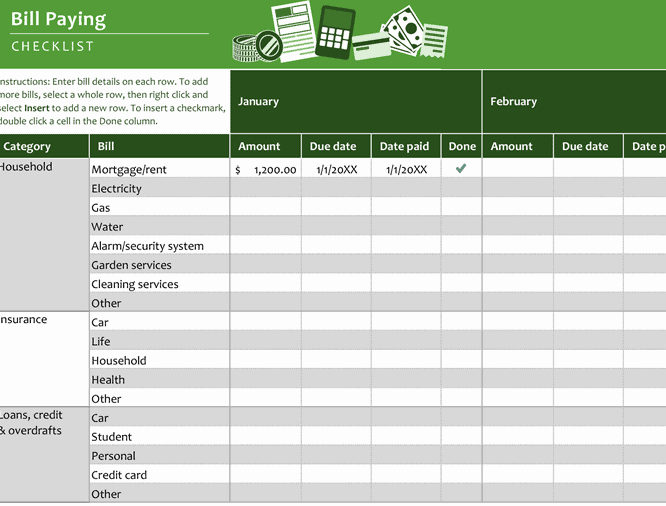
Keep track of the construction-related payments, take control of your cash-flow, and avoid late payment penalties. Download this template here.
Conclusion
A well-planned schedule is critical to completing a construction project successfully. However, making a construction schedule is complex. But, knowing a few basic steps can help simplify the endeavor.
Using project management software or spreadsheet templates can further make this process easy.
Toggl Plan is a popular tool that makes construction schedule planning easy. And, you can plan unlimited projects with it for free.
Get started with Toggl plan for free
How To Create A Construction Programme In Excel
Source: https://toggl.com/blog/how-to-create-a-flawless-construction-schedule-for-clients
Posted by: hoffmanvalinarts.blogspot.com

0 Response to "How To Create A Construction Programme In Excel"
Post a Comment